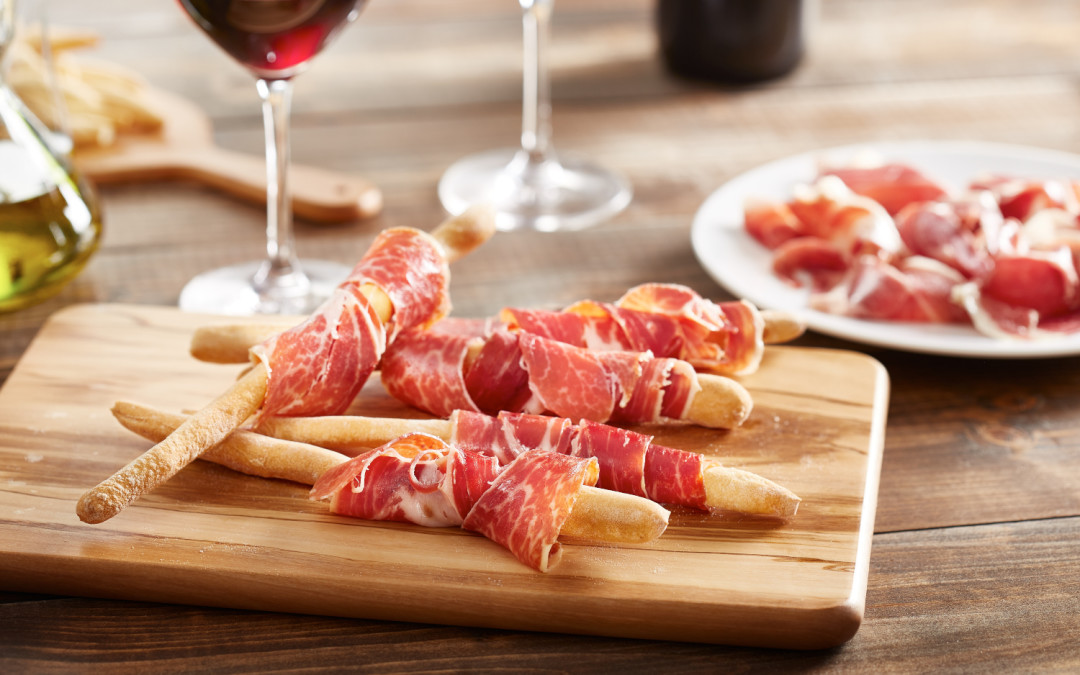Spanish Ham
It’s price rivals that of caviar and world class chefs are fascinated by it. But is Spanish ham worth pigging out on? Absolutely!
What makes a product so special that Ferran Adrià said of it that it should be served in every restaurant on earth? Spanish ham has been regarded as a delicacy since Roman times, but these days it is also considered a power food, because of its cardio-healthy properties. But buying and tasting Ibérico ham may be somewhat confusing as until recently Spanish laws were a bit of a mish-mash. So here’s what to look for when you are out to do your own ham tasting.
Spanish Ham, Ibérico Ham, Bellota Ham, Serrano Ham…? What’s in a name?
All these descriptors describe different types of Spanish ham, and sometimes are used interchangeably even by Spaniards, but they do not mean the same thing.
Ibérico is the name of the ham produced in four areas of Spain: Los Pedroches (in Córdoba), Guijuelo (near Salamanca), Huelva and Dehesa de Extremadura, under strict denomination of origin rules. Under these rules, the name Iberico is reserved for hams made from the black pigs of 100% Ibérico breeding (they may be crossbred up to 50% with other pig breeds, but the percentage must be stated in the label). These rules specify that the pigs are only fed with cereal and acorns (Bellota is Spanish for acorn) and bred freely in the Dehesa. The Dehesa is a man-created environment of grassland dotted with oak groves and Mediterranean herbs. Ibérico is generally regarded as the most superior type of Spanish ham and is sometimes referred to as Pata Negra, because of the characteristic black hoofs of the pigs.
When I was a child, Serrano used to be the name that encompassed all air-cured Spanish ham. These days Serrano designates ham which comes from white pigs. Are they inferior to Ibérico? This is a matter of hot debate and personal taste! Ibérico is generally regarded as the best type, but Serrano ham can also be exceedingly tasty (not to mention much a lot cheaper), so it makes for a really great starter ham. Look for hams from de Denominations of Origin Teruel or Trévelez.
Paletilla or paleta are hams made from the front legs of the pig, while hams from the back legs are more meaty. Some people prefer the fact that paletillas are slightly drier and saltier.
So how is Ibérico ham made?
A Diet of Acorns
To start with, we need a pig. As we have already seen, this can be a purebred Ibérico pig, or, more commonly, a cross of Ibéricos with other breeds such as Duroc, Large White or Landrace. These other breeds are also used on their own to make non-Ibérico ham. The Ibéricos spend their lives roaming around the Dehesa. During the months from October to January, the Ibéricos feast on acorns from the oaks in the Dehesa, which will not only give them a unique, oily taste, but will also provide them with some of their healthy characteristics (more on this later).
Salting and Drying
It is worth noting that the biggest differences in taste and price of a ham do not depend solely on the breed of the pig, as much as it is the highly specialized and time consuming process of salting and drying. Once the pig is sacrificed and butchered, the legs will be carefully removed (“shaped”) of their outer fat, and the blood will be extracted. By the way, the rest of the meat is not wasted: you may either find it in local Spanish restaurants (where a piece from the back of Ibérico pigs called “secreto” is often served grilled as a delicious entrée) or transformed into all sorts of cured meats, such as chorizo, lomo, or other local, Spanish delicacies.
The legs are covered in a mountain of salt, where they will be left for many weeks. This is perhaps one of the most complicated parts of the process, as it requires great skill to determine how long the legs should remain under salt and if a ham has been properly salted. After salting, the legs will them be hung in bodegas or natural drying spaces, where time (some of the legs will be stored up to three years) and fresh air will do the rest slowly drying the ham to turn it into a great delicacy!
What do I look for in a Spanish ham? Do I buy it cut or should I do it myself?
If you are going to splurge on Spanish ham, its important that you serve it properly. Ham that is not served at room temperature will not it have its characteristic melty, oily, piggy, nutty, all umami good tastiness. Its a good idea to buy it precut if you don’t know what you doing. Ham slicing is a very specialized skill, and ham carvers make a good living in Spain being in especially high demand during the holidays. Another reason to buy precut – Its not easy to get the most meat from of a piece of ham, so avoid buying it whole to avoid waste. If possible, buy the ham that is hand-carved, as machine cutting, while acceptable, is definitely not the same. In Spain, you can often find packs of small trimmings of ham leftover from the cutting process. They are a cheaper and still delicious.
Is Spanish Ham really healthy?
And yes, you can eat ham to your heart’s content, literally, because studies from Hospital Ramón y Cajal in Spain have shown that jamón 100% Ibérico lowers your blood pressure and contains high levels of oleic acid from those acorns, which in turn is beneficial to your cardiovascular health. So, go on, indulge… it might not make your life longer, but it will definitely make it more enjoyable!
Interested in purchasing some Spanish Ham without going to Spain (this won’t be as fun as going to Spain, though!)? You can purchase Spanish Ham at Iberico.com or Tienda.com. And, no The Culinary Exchange is not affiliated with these companies and makes no money from the sale of Spanish Ham. We just know that you can get the genuine article shipped to you in the US from these companies.
I hope you enjoy!
Mar Calpena is a widely published Spanish author and lover of Spanish Ham! More of Mar’s writing can be found on her website (in Spanish, of course) at www.unaodoscopas.com You can follow her on twitter @unaodoscopas and on Facebook.
Keep Eating! Keep Innovating!
Have you ever had Spanish Ham? Which is your favorite? Do you have a recipe to share? Let us know all about it in the comments or on Facebook.
The Culinary Exchange can also be found on Twitter, Instagram, Pinterest, Google+ and YouTube.
Come On! Follow Along!







Hi! I know a site whose really fit fot this topic. Well, i can say that this site is really great and delicious (because of the ham’s). Haha. Try to check it out! It’s : http://www.iberico-ham.co.uk/
Now i know the difference between all of the hams. Thank you so much to your site. Godbless you. Hope to learn more from you!